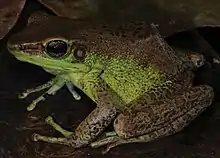Amnirana lepus
Amnirana lepus is a species of frog in the family Ranidae. It is found in Cameroon, Equatorial Guinea, Gabon, Central African Republic, Republic of the Congo, Democratic Republic of the Congo, and northern Angola.[1][2][3][4] Common names Andersson's Cameroon frog, Andersson's white-lipped frog, and jumping white-lipped frog have been proposed for it.[2][4]
| Amnirana lepus | |
|---|---|
 | |
| Female Amnirana lepus from Angola | |
| Scientific classification | |
| Kingdom: | Animalia |
| Phylum: | Chordata |
| Class: | Amphibia |
| Order: | Anura |
| Family: | Ranidae |
| Genus: | Amnirana |
| Species: | A. lepus |
| Binomial name | |
| Amnirana lepus (Andersson, 1903) | |
| Synonyms[2] | |
| |
Description
Males grow to a snout–vent length of 70 mm (2.8 in) and females to 100 mm (3.9 in). The body is elongated and the snout is moderately pointed, rounded in lateral view. The tympanum is relatively large. The legs are slender and long. The toes are fully webbed. The finger and the toe tips bear discs. The upper surfaces are dark to bronze-brown, possibly with darker spots. The flanks turn to pale green in their lower part and have some dark patterning. The venter is pale green. Males do not have an external vocal sac, but they do have short oval glands in their upper arms and nuptial pads on the thumbs. The male advertisement call is a quiet, high-frequency, unobtrusive "ouic, ouic", with some deep chuckles in between and ending with a "hik".[3]
Habitat and conservation
Amnirana lepus is a lowland forest species that also can occur in gallery forests and heavily degraded former forest (farm bush). It is often found along the banks of large, slow-flowing streams and small rivers, its breeding habitat. It is a common and adaptable species that is not facing any significant threats. Furthermore, it is present in a number of protected areas.[1]
References
- IUCN SSC Amphibian Specialist Group (2013). "Amnirana lepus (errata version published in 2016)". IUCN Red List of Threatened Species. 2013: e.T58198A89361810. Retrieved 22 August 2020.
- Frost, Darrel R. (2020). "Amnirana lepus (Andersson, 1903)". Amphibian Species of the World: An Online Reference. Version 6.1. American Museum of Natural History. doi:10.5531/db.vz.0001. Retrieved 22 August 2020.
- Channing, Allan & Rödel, Mark-Oliver (2019). Field Guide to the Frogs & other Amphibians of Africa. Cape Town: Struik Nature. p. 394. ISBN 978-1-77584-512-6.
- Marques, M. P.; Ceríaco, L. M. P.; Blackburn, D. C. & Bauer, A. M. (2018). "Diversity and distribution of the amphibians and terrestrial reptiles of Angola. Atlas of historical and bibliographic records (1840–2017)" (PDF). Proceedings of the California Academy of Sciences. 4th Series. 65 (Suppl. II): 1–501.
